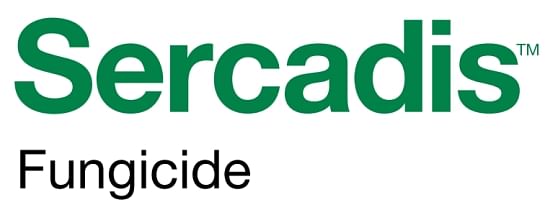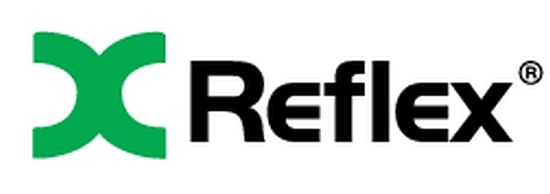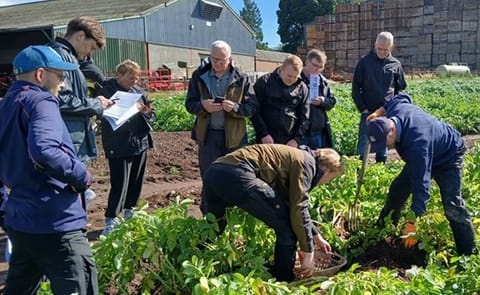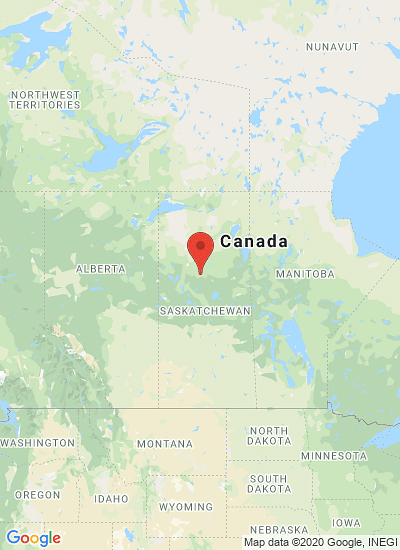Potato Field in Bloom on Prince Edward Island, August 2015 (PotatoPro)
New potato protection products available in Canada for 2016

In 2016 a number of new crop protection products for use in potato cultivation are available in Canada.
Country-guide.ca offered the following overview:
Forum
BASF’s Forum was expected to be registered in January 2016, says Scott Hodgins, manager for BASF Canada in Mississauga, Ontario. Forum is composed of an active ingredient already used in the fungicide Zampro SC — dimethomorph, from the chemical Group 45.Forum’s mode of action makes it a highly systemic fungicide for the control of late blight in potato and other vegetable crops. Its antisporulating activity kills Phytophthora infestans, the spores of the late blight fungus, and protects the crop right at the beginning of infection.
Forum will be offered in an easy-to-use liquid formulation. Forum will always have to be tank mixed with a contact, registered fungicide.
Quadris Top
Quadris Top is a broad spectrum product composed of two fungicides. It offers preventive, systemic and curative properties for the suppression in potato crops of early blight (Alternaria solani), brown or target spot (Alternaria alternata) and black dot (Colletotrichum coccodes).Quadris Top (azoxystrobin, a Group 11 fungicide, and difenoconazole, a Group 3 fungicide) is now registered for the suppression of white mould (Sclerotinia sclerotiorum) when used at its highest rate (1 litre per hectare or 0,41 l/acre).
Sercadis
Registered in October 2015, BASF’s Sercadis is a new broad-spectrum and highly systemic fungicide for the control of early blight (Alternaria solani), white mould (Sclerotinia sclerotiorum), and Rhizoctonia canker or black scurf (Rhizoctonia solani).Sercadis is registered to protect fruits and vegetables from many groups: Group 1B (root vegetables), Group 1C (tuberous vegetables — like potatoes — and corm vegetables), Group 3 (bulb vegetables), Group 4 (leafy vegetables, except those from the genus Brassica), Group 5 (Brassica/cole/leafy vegetables), Group 8 (fruiting vegetables), Group 9 (cucurbit vegetables — cucumber/melon/squash), Group 11 (pome fruits like apple and pear), Group 12 (stone fruits), Group 13 (berries and small fruits, including grapes and strawberries), and Group 14 (including almonds).
Scott Hodgins, brand manager, horticulture and specialty at BASF:
“We believe Canadian fruit and vegetable growers will appreciate Sercadis, not only for its highly systemic activity against diseases, but also for its tank-mix flexibility.”Sercadis is mostly immediately absorbed by the plant, the rest forming a crystalline deposit tightly bound to the waxy layer of the leaf, from which it gradually releases the molecule throughout the plant. This fungicide inhibits spore germination and production of the fungus at the leaf surface, as well as the development of its mycelium.
“The active ingredient in Sercadis is fluxapyroxad brand name Xemium), a new compound within Group 7.”
“Sercadis belongs to the carboxamide class of fungicides within the SDHI family. Its highly systemic nature allows this fungicide to protect the plant as it grows. It is extremely mobile and moves across the plant with translaminar and ascending diffusion.”
Optimal disease control is obtained when Sercadis is applied preventively, as part of a regular spraying program and in rotation with other fungicides. Sercadis can be readily tank mixed with other products on the market and offers flexibility regarding crop rotation.
Spraying of Sercadis on potatoes should start early in the season for the control of early blight. Sercadis can then be applied at early flowering for controlling white mould (Sclerotinia sclerotiorum), using a non-ionic surfactant. When applied in the furrow, Sercadis delivers control of the soil-borne pathogen causing Rhizoctonia canker (Rhizoctonia solani). In the furrow, the fungicide must be sprayed along a band 10 to 20 cm (4-8 inches) wide.
Serenade SOIL
Registered in in May 2013, Bayer’s Serenade Soil is available since 2014 for the control of the following diseases on potato fields: Rhizoctonia canker (black scurf and stem canker), caused by Rhizoctonia solani, pink rot (Phytophthora erythroseptica), leak and seed piece decay caused by Pythium species and, finally, rots due to several fusarium species.This fungicide is made out with the bacteria Bacillus subtilis (Group 44) and is particularly popular among organic potato growers and those willing to prevent resistance problems due to the repeated use of pesticides from the same chemical groups. Serenade Soil acts as an armour for the potato roots.
What is new for this organic fungicide in 2016: it has been registered for the post-harvest suppression of silver scurf (Helminthosporium solani). It must be applied at the rate of 85 to 175 ml per tonne and with special attention to the quality of spraying. Indeed, these bacteria must completely coat the seed pieces. Disinfection and other cultural practices should also be used to help stop or minimize the presence of diseases on the tubers to be stored.
While Serenade Soil is not the only product registered for post-harvest treatment in potatoes, it can be considered as an additional tool for fighting against this increasingly widespread storage disease.
Sivanto Prime
The active ingredient of Bayer’s Sivanto prime insecticide is flupyradifurone. It was registered by Health Canada in November 2015. Sivanto prime controls insect pests affecting many vegetable (including potato) and fruit crops. It also controls sucking insects of potatoes, such as aphids and leafhoppers.*Sivanto prime is a broad-spectrum insecticide belonging to a new chemical class called butenolides/Group 4D. It has a systemic activity with acropetal translocation, that is, it moves from the roots to the leaves when applied in the soil (not for potatoes). When applied as a foliar spray, Sivanto prime moves in a translaminar way, in other words across the leaf tissue, which allows it to control insects feeding on the underside of the leaf. Sivanto prime is readily absorbed by the leaf tissue and is considered to be rainfast within an hour after drying. Its action is quick as well as residual. It protects the young leaves of potato plants. When sprayed against aphids, it results in the stopping of their honeydew production only 90 minutes after spraying, and this, even for those aphids feeding on the lower leaf surface.
Sivanto prime can be applied with air-assisted sprayers, either through ground or aerial applications. Contrarily to many Group 4 insecticides, Sivanto prime is only registered for foliar application on potatoes.
As with other pesticides, Sivanto prime must be applied alternately with insecticides from other chemical groups targeting the same insect pests.
All insecticides must be used according to an integrated pest management program which includes scouting and record-keeping, and includes cultural and biological practices as well as other methods of chemical eradication.
Reflex
Syngenta’s Reflex herbicide quickly kills emerged broadleaf weeds. It keeps the fields clean until row closure. It is registered for Eastern Canada only.The active ingredient of this Group 14 herbicide is fomesafen (an OPP inhibitor). It also controls or suppresses some weed phenotypes that resist herbicides from Groups 2 (rimsulfuron) and 5 (atrazine, metribuzin). Reflex is particularly effective for pre-emergence control of redroot pigweed, common ragweed and lamb’s quarter.
It must be applied immediately after hilling to prevent germination of the weeds mentioned on the label. Syngenta Canada recommends not to apply Reflex on soils having more than five per cent organic matter or on fine-textured soils.
It cannot be applied, in the same field, more than once.
Like to receive news like this by email? Join and Subscribe!
Get the latest potato industry news straight to your WhatsApp. Join the PotatoPro WhatsApp Community!
Highlighted Company
Sponsored Content
Sponsored Content
Sponsored Content
Sponsored Content















